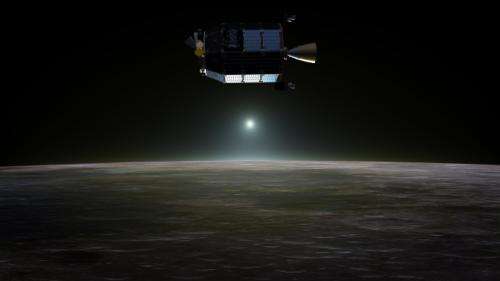NASA Goddard plays major role in NASA lunar mission

(Phys.org) —In partnership with NASA's Ames Research Center in Silicon Valley, Calif., Goddard's Wallops Flight Facility will launch the Lunar Atmosphere and Dust Environment Explorer known as LADEE in September, a robotic mission that will study the moon's thin atmosphere and dust particles.
Ames manages the 100-day mission—-which will attempt to confirm whether dust caused a mysterious glow on the lunar horizon astronauts observed during several Apollo missions—and Goddard plays a variety of key roles in LADEE.
After launch, Ames will control the spacecraft and execute mission operations. Goddard is responsible for the LADEE launch and several important LADEE components, including the instruments, demonstrations of the mission's payload and science operations.
"We wanted to do a mission that would benefit both centers," LADEE payload manager Robert Caffrey said. "It's a good model for centers working together to achieve common goals."
LADEE's launch in September from Virginia's Eastern Shore marks the facility's first launch to the moon. Wallops will provide the launch services and range operations as well the launch vehicle, a U.S. Air Force Minotaur V rocket. LADEE will be the first spacecraft to launch on this rocket.
One of Goddard's biggest roles on LADEE is to manage the mission's four instruments and demonstrations. Three of the payload instruments—the Neutral Mass Spectrometer or NMS, Ultraviolet and Visible Light Spectrometer and the Lunar Dust Experiment or LDEX—will study the lunar atmosphere composition and analyze lunar dust.
Developed at Goddard, the NMS will measure variations in the different gases of the lunar atmosphere while the spacecraft orbits the moon. A similar spectrometer will fly aboard the Mars Atmosphere and Volatile Evolution Mission, scheduled to launch in November
"The Goddard Neutral Mass Spectrometer team is delighted to provide this instrument to the LADEE mission and contribute to this mission's exploration of the tenuous atmosphere of the moon," said Goddard NMS Principal Investigator Paul Mahaffy.
LADEE will also host the Lunar Laser Communications Demonstration or LLCD mission payload. LLCD is an innovative laser technology that could one day replace radio waves currently used in satellite communications and is expected to transmit more data at faster rates.
Together with the Massachusetts Institute of Technology's Lincoln Laboratory— which designed and developed the technology—Goddard has been looking for opportunities to test laser communications in space for more than 10 years. If the demonstration aboard LADEE is successful, LLCD mission manager Don Cornwell said the technology could be used in future missions as a serious upgrade for space communications.
"This technology could affect everything from live experiments on the International Space Station to scientific and human missions to the moon and beyond," Cornwell said. "The big goal is to show it works under as many conditions as possible and to build confidence for other missions to use it."
"The state-of-the-art technology—which will be demonstrated using both test patterns and potentially real LADEE data—represents one of many firsts taking place on the LADEE mission," Cornwell said
Once LADEE launches, Goddard employees will monitor all of the instruments from Goddard's Science Operations Center and instruct the Ames Mission Control Center how to operate them. Individual instrument operations centers will focus on details of each instrument.
Science Operations Center co-lead Dan Smith said Goddard employees would be overseeing all of the payload activities and planning each instrument's weekly itinerary.
"Our group coordinates and orchestrates all instrument activities," said Smith. "Ames is busy enough flying the actual spacecraft, our job is to focus on the instruments."
Smith said the Science Operations Center would also receive all of the instrument data and distribute it to each instrument's operations center.
"Goddard is basically a liaison between the instruments and the spacecraft," Caffrey said.
A large amount of data transmitted from the LADEE spacecraft will be received through Goddard's White Sands Complex in Las Cruces, N.M.
Because Goddard has a rich history of managing missions, its engineers supported Ames in developing many critical parts of the mission, including flight software, Smith said.
"A lot of the software we're using for LADEE are products that have come out of Goddard," Smith said.
Ames is using the same Goddard-developed core flight software for LADEE that Goddard has used aboard previous missions. In fact, much of the mission control center software being used on this mission has been used on past missions.
While this mission is unique because of the payload and the combined efforts between Goddard and Ames, Science Operations Center co-lead Jennifer Sager said, "LADEE also stands out because a low cost requirement allowed Goddard to get creative with mission management."
"It has allowed us to do things outside of the box," Sager said, adding that Goddard employees built much of the Science Operations Center using computers and furniture from other Goddard projects and found ways to collaborate with other new missions to share common expenses. "We've been able to do stuff other missions haven't been able to do."
"It's been a challenge, but overall I think it's been a positive experience," Sager said. "We'll be very busy."
Caffrey said that the LADEE mission represents many different aspects of NASA makes it particularly inspiring.
"LADEE is a historic mission, and it's exciting that Goddard, both Wallops and Greenbelt, have such a large role in it," Caffrey said. "The breakthroughs in this mission, from resolving a past Apollo mystery to demonstrating future communications capabilities, is very exciting for NASA."
Provided by NASA's Goddard Space Flight Center



















